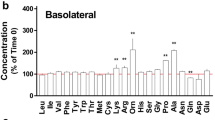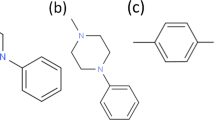Abstract
Absorption mechanisms of L- and D-methionine (MET) in an in vitro cultured human intestinal epithelial cell model (Caco-2) and an in situ perfused rat intestinal model were investigated to determine if the kinetic characteristics of absorption are comparable in these two popular absorption models. The results indicate that the transport of L- and D-MET were concentration-dependent in both model systems, and displayed comparable Km values. The Km value for L-MET is 1.34 mM in the Caco-2 model and 3.6 mM in the perfused rat intestinal model, while the Km value for D-MET is 1.79 mM in the Caco-2 model and 2.87 mM in the perfused rat intestinal model. Although the Jmax values were not comparable because of significant methodology differences, the Jmax values for L-MET were always higher than that for D-MET. In addition, transport of L- and D-MET across the Caco-2 cell monolayers were also inhibited by 10 mM Phe and Lys while MeAIB, Pro and Glu were generally ineffective. Similar results were also observed with these inhibitors in the perfused rat intestinal model with the exception that a combination of Pro and Glu stimulated the uptake of L-MET. In conclusion, the transport characteristics of L- and D-MET are comparable in both model systems.
Similar content being viewed by others
REFERENCES
I. Osiecka, M. Cortese, P. A. Porter, R. T. Borchardt, J. A. Fix, and C. R. Gardner. Intestinal absorption of α-methyl-L-dopa: in vitro mechanistic studies in rat small intestine segments. J Pharmacol. Expt. Ther., 242, 443–449 (1987).
M. Hu and R. T. Borchardt. Mechanism of L-α-methyldopa transport through a monolayer of polarized human intestinal epithelial cells (Caco-2). Pharm. Res., 7:1313–1319 (1990).
P. J. Sinko, M. Hu, and G. L. Amidon. Carrier-mediated transport of amino acids, small peptides, and their drug analogs. J. Control. Rel., 58, 1196–1200 (1987).
B. H. Stewart, A. R. Kugler, P. R. Thompson, and Howard N. Bockbrader. A saturable transport mechanism in the intestinal absorption of gabapentin is the underlying cause of the lack of proportionality between increasing dose and drug levels in plasma. Pharm. Res., 10:276–281 (1993).
D. C. Kim, P. S. Burton, and R. T. Borchardt. A correlation between the permeability characteristics of a series of peptides using an in vitro cell culture model (Caco-2) and those using an in situ perfused rat ileum model of the intestinal mucosa. Pharm. Res., 10:1710–1714 (1993).
M. Pinto, S. Robine-Leon, M. D. Appay, M. Kedinger, N. Triadou, E. Dussaulx, B. Lacroix, P. Simon-Assmann, K. Haffen, J. Fogh, and A. Zweibaum. Enterocyte-like differentiation and polarization of the human colon carcinoma cell line Caco-2 in culture. Biol. Cell. 47:323–330 (1983).
I. J. Hidalgo, T. J. Raub, and R. T. Borchardt. Characterization of the human colon carcinoma cell line (Caco-2) as a model system for intestinal epithelial permeability. Gastroenterology, 96:736–749 (1989).
M. Hu and R. T. Borchardt. Transport of a Large Neutral Amino Acid in a Human Intestinal Epithelial Cell Line (Caco-2): Uptake and Efflux of Phenylalanine. Biochim. Biophys. Acta, 1135:233–244 (1992).
A. Dantzig and L. Bergin. Uptake of the cephalosporin, cephalexin, by a dipeptide transport carrier in the human intestinal cell line, Caco-2. Biochim. Biophys. Acta. 1027:211–217 (1990).
M. Hu. Comparison of transport characteristics of thymidine and zidovudine in a human intestinal epithelial model system. J. Pharm. Sci. 82, 829–833 (1993).
I. J. Hidalgo and R. T. Borchardt. Transport of bile acids in a human intestinal epithelial cell line, Caco-2. Biochim. Biophys. Acta, 1035:97–103 (1990).
A. Blais, P. Bissonnette, and A. Berteloot. Common characteristic for Na+-dependent sugar transport in Caco-2 cells and human fetal colon. J. Membr. Biol., 99:113–125 (1987).
M. Hu, P. J. Sinko, A. L. J. DeMeere, D. A. Johnson, and G. L. Amidon. Membrane permeability parameters for some amino acids and β-lactam antibiotics: application of the boundary layer approach. J. Theor. Biol., 131:107–114 (1988).
D. A. Johnson and G. L. Amidon. Determination of intrinsic membrane transport parameters from perfused intestinal experiments: a boundary layer approach to estimating the aqueous and unbiased membrane permeabilities. J. Theor. Biol., 131:93–106 (1988).
G. L. Amidon, P. J. Sinko, and D. Fleisher (1988). Estimating human oral fraction dose absorbed: a correlation using rat intestinal membrane permeability for passive and carriermediated compounds. Pharm. Res., 5:651–654 (1988).
P. J. Sinko, G. D. Leesman, and G. L. Amidon. Predicting fraction dose absorbed in humans using a macroscopic mass balance approach. Pharm. Res. 8:979–988 (1991).
M. Bradford. A rapid and sensitive method for the determination of microgram quantities of protein utilizing the principles of protein-dye binding. Anal. Biochem. 72:248–254 (1976).
R. T. Borchardt, I. J. Hidalgo, K. M. Hillgren, and M. Hu. Pharmaceutical application of cell culture: an overview. In “Pharmaceutical application of cell and tissue culture” (G. Wilson, S. S. Davis, and L. Illum, eds.), New York, pp. 1–4 (1990).
H. N. Christensen. Role of amino acid transport and countertransport in nutrition and metabolism. Physiol. Rev., 70:43–77 (1991).
B. G. Munck. Intestinal absorption of amino acids. In “Physiology of the Gastrointestinal Tract” (L. R. Johnson, ed.), Raven Press, New York, 1097–1122 (1981).
H. N. Christensen. Exploiting amino acid structure to learn about membrane transport. Adv. Enzymol. Relat, Areas Mol. Biol., 49:41–101 (1979).
Author information
Authors and Affiliations
Rights and permissions
About this article
Cite this article
Zheng, L., Chen, J., Zhu, Y. et al. Comparison of the Transport Characteristics of D- and L-Methionine in a Human Intestinal Epithelial Model (Caco-2) and in a Perfused Rat Intestinal Model. Pharm Res 11, 1771–1776 (1994). https://doi.org/10.1023/A:1018923618747
Issue Date:
DOI: https://doi.org/10.1023/A:1018923618747




